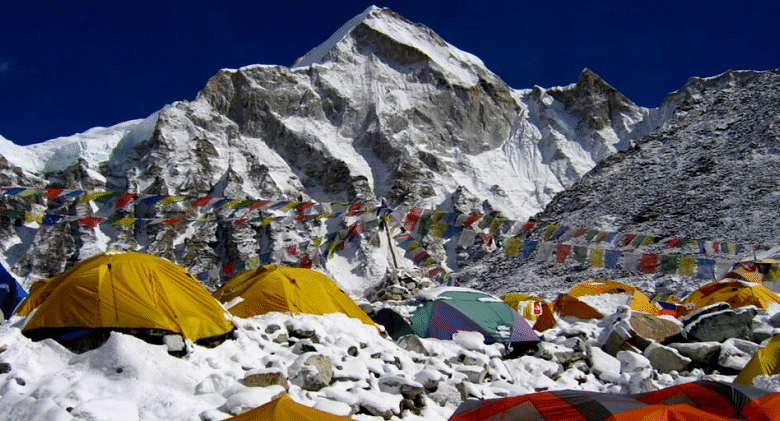How to maintain flexibility in the cold weather of the Everest Trek

The Majestic, as it looks, the Himalayan cold does push every trekker over the limits of endurance, balance, and body flexibility. When the mercury starts to dip below 0, needing some flexibility isn’t a want, but rather a need-to-stay-alive situation. The thin air, which is low in oxygen; the long hours walking over ice and snow; the subzero temperatures can tighten up muscles, hinder blood flow, and make even a short step a struggle. Learning to stay supple in the cold on the Everest Trek will help you move freely, preventing injury, and acclimatize. Whether you are booking your own adventure through an Everest Base Camp trek package or joining a local agency, preparing your body for the chill is just as important as making boots or jacket decisions.
The Everest Base Camp and its surroundings explained.
Before we get into the flexibility exercises, it’s a good idea to have an idea about what sort of cold weather you can expect on the Everest Base Camp trek route. Starting with the short flight to Lukla, at around 2,860 meters, you’ll ascend steadily above 5,000 meters near Base Camp. As you gain altitude, temperatures drop sharply – especially mornings and at sunset. While trekking to Everest Base Camp from Kathmandu, you will possibly encounter a lot of dust in Phakding, but biting wind chills in Dingboche or Lobuche. The body’s inevitable response to such cold is to tighten muscles and inhibit blood flow in order to conserve heat. However, for trekkers, this response is detrimental to balance, mobility, and performance. Remaining flexible will help you compensate for uneven ground and long hours of walking.
Everest base camp trek map. 1 This is a physically demanding trek; the gradient of stepping up and down to spot from thing is dramatic, therefore, a good level of flexibility in terms of stability is required. Sizes: XS to L. Icy trails and varying temps can lead to strained or tired muscles. Knowing how cold impacts your body means you can adopt habits to help keep the joints supple and the muscles warm.
Pack your body for the trip.
Physical Conditioning for Everest Region Preparation to visit the Everest trek also starts well before you even arrive on your trek. Trekkers, especially those who have been practicing for several months before their Everest Base Camp trek 2025, can feel a phenomenal change in endurance and flexibility. Yoga, dynamic stretching, and mobility workouts are excellent ways to establish the base. Doing some flexibility in a cold place will allow your body to get used to what you’ll be facing in the Himalayas. Your guide, on your Everest Base Camp trek, is always repeating!” It’s not just about stretching muscles but maintaining circulation and an awareness of our bodies.
With stretches for hamstrings, calves, hips, and lower back, you’ll be ready for the steep trails up to Namche Bazaar and down to Tengboche. The use of trekking poles can also decrease tension in your leg muscles while promoting increased freedom of movement. Stretching each morning before hitting the trail will also prevent injury in the body that tries to leap into action in sub-zero air. Staying flexible means your body will be able to negotiate the varied terrain listed in the Everest Base Camp trek map, from its rocky inclines to its icy downward slopes.
Keeping Flexible During Your Everest Base Camp Trek
Once you start needing to climb, stretching every day is a routine occurrence. The Everest Base Camp trek’s best time period – usually between March and May, as well as from September to November – still experiences cold mornings and nights, sometimes radically below zero degrees. In the mornings, begin with light stretching in the tea house to warm up your muscles before going outside. While you are walking, take slow and steady steps to prevent your joints from becoming stiff. Even the cadence of walking itself can facilitate circulation if performed mindfully.
Colder temperatures and along with a decrease in oxygen, more affected us at higher altitudes of Dingboche and Lobuche. This combination increases muscle stiffness. In between, take short breaks every hour to stretch out your shoulders, legs, a nd neck. Staying hydrated also helps with flexibility, because being dehydrated can cause muscles to feel more sore. Sip as: From your adventure guide on the Everest base camp hike, he will remind you to drink lots of water to keep the circulation and oxygen going, even if the water in general is not so inviting.
Managing Altitude and Muscle Stiffness
As you climb higher, the Everest Base Camp trek altitude sickness challenge becomes an extra layer of effort required to maintain flexibility. Muscles don’t recover as quickly, and overall soreness may spike due to lower oxygen levels. Use the acclimatization days in your Everest Base Camp trek itinerary, usually at Namche Bazaar and Dingboche, for mild stretching (yoga is a remarkable option) or a brief stroll. Shifting around in the course of those breaks will preserve your joints lubricated and your muscle mass warm, and help prevent them from locking up inside the bloodless.
The fatigue and lethargy that altitude sickness brings about also tend to make hikers stand still longer than they should. But gentle movements can help increase the flow of oxygen and ease that stiffness. Your Everest Base Camp trek guide will be urging you to stay active at your comfort level on rest days. This mix of approaches helps your body to adapt, while remaining agile and robust.
Recovery and Flexibility After Trekking
Recovery is as important once you have arrived and either finished your Everest Base Camp helicopter return trek or made it to base camp. The descent can be just as tough on the body as the ascent, and flexibility is essential to ensure you are free of post-trek aches and pains. Easy rolls, heating pads, a nd light yoga all contribute to the recovery process by stretching out tight muscles and increasing blood flow. On returning to Kathmandu, many trekkers indulge in gentle walks and spa treatments to soothe weary muscles.
Travelers who hike with a local agency often get useful Everest Base Camp trek tips about post-trek care. Keeping limber once you’ve arrived not only helps combat fatigue, but it also prepares your body for the next great adventure. And once you are home again, keeping up with a stretching regimen keeps your joints healthy and strong for the long term.
Conclusion
Flexibility in the extreme of the Everest Base Camp trek can be a silent ingredient for success. It keeps your body nimble and your steps stable, and fuels that indomitable spirit as you confront the punishing Himalayan wind. Getting ready to go, dressing in the right way, and drinking plenty of water, with a little help from that stretching routine you use every morning. Whether you make the journey on your own, with friends, or within a Mount Everest Base Camp trek package deal, it will save you from injuries and fatigue that are unwarranted.
As you prepare for your Everest Base Camp trek 2025, focus not just on gathering all the necessary gear and Everest Base Camp trek permits but also on how your body is going to move. And remember, the more flexible you can remain, the more energy you’ll have in store for the climbs ahead. Your hike is more than just a physical journey — it’s the emotional and psychological one. Staying bendy while the cold bites enables you to revel in Everest in all her glory: every sunrise from the Khumbu, each snow-lined ridge, and each breath of the thin air. Flexibility is not simply how much you may bend, yield, and stretch; it’s miles how you could withstand, adapt, and flourish in the midst of the Himalayas.



